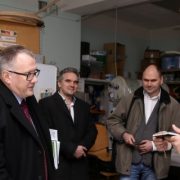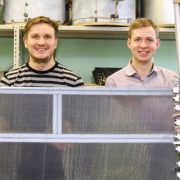RTU scientists prove themselves in the world space research
We need to be once in four five years alive, proven and in the right place, at the right moment, says the leading researcher Kaspars Kalniņš, the RTU FCE Institute of Materials Science and Design Institute (RTU FCE), in the broadcast “Eyewitness”.
Scientist with a space grip – this is what she describes as the creator of the program. Mr Kalnins told ATV that he has been working with the German Space Agency for 15 years and has been at the US Space Research Center at NASA. Now scientists of the RTU Faculty of Civil Engineering, headed by K. Kalniņš, are developing space satellite technologies for the European Space Agency, which will increase the security of the satellites and will significantly reduce the costs of manufacturing and operating costs for future missions.
K. Kalniņš says that the task of RTU scientists is to investigate the impact of visually difficult damage on space satellite structures and to test the structural impact of the bearing bearing capacity. Based on the analysis of the research findings, scientists will develop guidelines for the European Space Agency for the construction of new satellites. The RTU study will allow the manufacturing process to verify the reliability of the satellite design and, if necessary, to replace it in time without risking the mission or damage to the aircraft in open space.
In the space industry, seemingly minor mistakes can cause millions of losses. The scientist in the program mentions an example of an unsuccessful Mars expedition – how much has it cost the billion, how many thousands of people work “tangled up” just because someone did not count something, not completely tested. K. Kalniņš says that one problem that exists in science – people do not try to check if the experiments are reliable. “The German Space Agency has invested several millions only in the test procedure alone. They have grown to the last nancy for 30 years, “says Kalnins. Therefore, Latvian scientists must first prove that “we will not be guilty” because the German does not understand how three, four or five scientists in Latvia can do the same thing as a 500-strong institute in Germany. “This means that we work at least five times the capacity than they would do,” says K. Kalnins about experiments and their quantity.
For the development of the guidelines necessary for the European Space Agency, the researchers obtain information from satellite laboratories prototype in RTU laboratories from certified materials. They are used to simulate the damage that occurs in the constructions due to transport and assembly. In different tests, scientists are testing how the bearing capacity of the structure varies depending on the type and location of the damage. In turn, test results are used in computer simulations, which allows predicting behavior for much larger combinations.
“Self-demonstration – we proved more than required from us. This means that colleagues and partners keep in touch with us. Continuity is the most difficult, “says K. Kalniņš about the situation in Latvia. Why is it? “We have to work ourselves. Let Germany know that we have to work. That the Frenchman understands – we have to work, because those brave people did everything, “says RTU scientist.
Broadcast “Eyewitness” (Jan 21, 2017)

